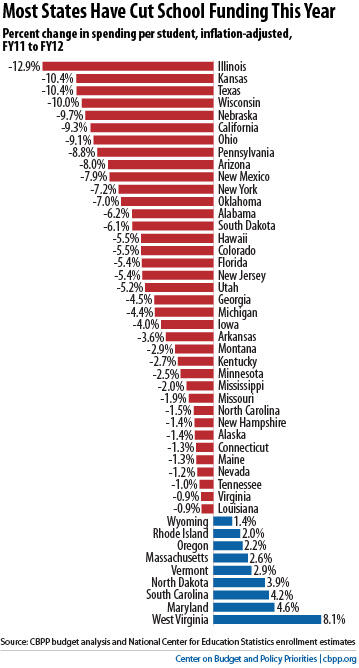The great majority of states have cut per-pupil funding for elementary and secondary schools for the current school year, our new survey of state K-12 budgets finds. Funding in most states is now below pre-recession levels, after adjusting for inflation.
The survey covers 46 states (all except Delaware, Idaho, Indiana, and Washington), which are home to 95 percent of the nation’s schoolchildren. Here are the highlights:
- Some 37 states have cut funding below last year’s levels, after adjusting for inflation. Nineteen of them have cut funding by more than 5 percent (see graph).
- Some 30 states are funding K-12 education at lower levels than they were four years ago, after adjusting for inflation. Seventeen of them have cut funding by more than 10 percent.
- The biggest funding cuts compared with four years ago are in Arizona, California, Hawaii, and South Carolina, where they exceed 20 percent.
These cuts have serious economic consequences. In the short term, they force school districts to take actions that can slow the recovery, like laying off teachers and scaling back purchases of private-sector goods and services. Schools cut 194,000 jobs between August 2010 and August 2011.
In the long run, the cuts make it more difficult to train the highly educated workforce that this nation will need to thrive in an increasingly global information economy.
With the economy still weak and state revenues still below pre-recession levels, states are likely to continue to face major budget challenges in the coming year. To avoid digging the education funding hole even deeper, states should take a balanced approach to addressing these challenges — an approach that includes raising additional revenues.
The federal government can also play a role, as my colleague Michael Leachman points out, by providing extra education aid for states and localities, such as the aid the President proposed in the American Jobs Act to retain and hire teachers and other school workers.

